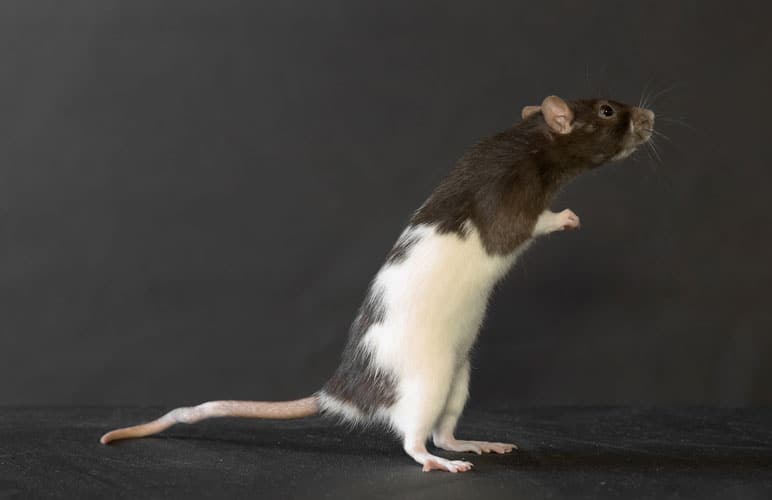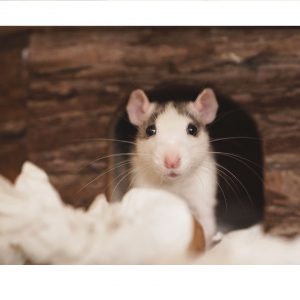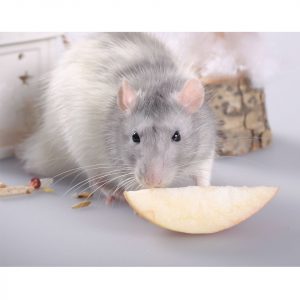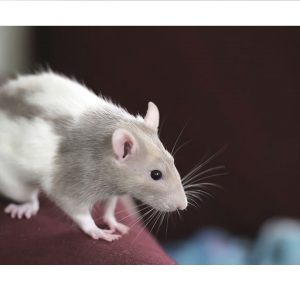Most animals have different diets and routines, so we don’t feed them the same way we do. Pet rats are at significant risk of obesity since they’ll eat everything as long as it is within reach.
Since they have particular nutritious needs, it’s also easy for them to go underweight if not given a balanced diet.
But how can you tell if your pet rat has a healthy weight?
Your pet rat has a healthy weight if they don’t have a lot of bones showing through the fur, but you can still see the spine well enough. Your pet rat is underweight if you can see its ribs and spine sticking out. And your pet rat is overweight if you can’t quite tell the difference between their spine and the rest of the body, and they drag their body on the floor.
But what can you do to keep your pet rat at a healthy weight? How can you fatten your pet rat or keep them on a diet? Let’s discuss this in this article with some handy tips!
What’s A Healthy Weight For A Pet Rat?

Despite their size, rats have a recommended weight that can classify them as healthy and normal. They mustn’t go beyond or below this healthy weight range.
Depending on the gender and breed, rats should maintain an ideal weight of between 0.44 to 1.5 pounds.
If they exceed that weight or do not meet that standard, you must look further into your rat’s diet.
When rats are born, they weigh only about 6 to 8 grams. They are tiny, with no fur, barely reaching the size of a coin. But they seem to expand and grow in a week and can put on an extra 10 grams with subtle differences in appearance.
Weight On Male Rats Vs. Female Rats
Male rats are chunkier, but on average, a female adult rat should weigh 0.44 to 1.1 pounds. In comparison, its male adult counterpart weighs 0.88 to 1.5 pounds.
Generally speaking, male rats tend to grow bigger than females, so they’ll naturally weigh more.
However, these are very subtle changes; their size or weight varies more due to their environment or even genetics than their gender.
If you are unsure whether to get male or female pet rats, you should consider their demeanor.
For example, female pet rats tend to be more energetic and curious, while males are more prone to cuddling and staying on your lap.
But of course, every pet rat has their personality. They’re all different, so it’s good to spend some time with them before bringing pet rats home. So you can better learn their characters.
As for their weight, as long as they are given the recommended amount of food and some fresh fruits and veggies, your pet rats will live healthily and happily!
Understanding the quantities you should give your pet rats can be challenging, but we covered you with our How Much To Feed Your Pet Rat article.
How To Fatten Up An Underweight Rat
Any pet owner who notices their pet starting to lose weight or not gaining any weight while still being energetic and active will be concerned.
All seems to be well with your rat, except it remains underweight.
The best way to fatten an underweight rat is to make some changes to its diet. Rats in the wild consume an omnivorous diet of seeds, grains, plants, and some animal proteins if they’re lucky.
A variety of meals should be enough for pet rats to acquire the necessary nourishment.
You can provide this balanced diet with acceptable preservatives and flavors. Throw in some fresh food because rats are fond of these meals.
If you’re giving them balanced meals and still notice your pet rat is not gaining sufficient weight, there are some healthy foods you can give them to help out.
Here are a few examples:
#1. Cooked Corn
Rats love cooked corn, and this can help them gain weight. This food is rich in fiber, and it helps with digestion.
It’s important to note that you shouldn’t give your pet rat dry corn since those can quickly grow mold without our notice.
This mold harms your pet rat and might make them severely sick!
#2. Pumpkin Squash
Pumpkin is a nutritious and delicious meal you can regularly incorporate into your rat’s meal.
It contains plenty of essential vitamins that can improve your rat’s immune system and the right amount of calories necessary for your pet’s health.
If the first time you notice orange and softer droppings from your pet rats, don’t worry! It’s due to the pumpkin since they’re not used to eating it.
Their droppings should be fine once the pumpkin has been digested!
#3. Oatmeal
You can also introduce oatmeal to add variety to your pet rat’s diet. Oats can help your rat gain weight, especially if you add some coconut oil to it after cooking it.
This food is richer in protein than most known grains, so you can be sure that this will help your pet put on weight.
Even if these can help, it’s always good to first contact or take your pet rat to the vet. They can give you more food recommendations and even prescribe a supplement to help your pet rat gain some weight!
Your vet will also be able to check out the underweight pet rat and more easily understand what could be missing from their diet.
How To Put An Overweight Rat On A Diet

If you observe that your pet rat has become overweight, watch out. A rounded rat may look adorable, but it is not healthy for your pet.
If your pet has gained excess weight, this is a warning sign that something is amiss and that you should start watching your rat more closely.
You don’t want your rat subjected to health conditions like cardiovascular diseases and diabetes.
It is time to put your rat on a diet, and you play a significant role in making this happen.
Here are ways how to put your overweight rat on a diet:
#1. Store Foods The Right Way
One of the main reasons your rats will become overweight is giving them food not intended for rats.
Remember that rats will eat anything, so ensure that your food and their food are securely stored so they can’t get into it and have an eat-all-you-can day whenever they feel like it.
You can also consider starting to give them more than one meal a day, with just the recommended amount, if you don’t do it already.
This will create a schedule, and your pet rat will start to understand they have a limited amount of daily food divided throughout the day.
#2. Give Them The Correct Treats
The type of food your rat is eating and snacking on is another factor that can contribute to its weight.
Although fatty foods and sugary treats are pleasurable, too many of these can add to the unwanted calorie intake.
It is time to stop if you enjoy spoiling your rat with cookies, fast food, and other seasoned foods.
These are delicious but have zero nutritional value, so refrain from giving your rat these treats.
If you want to treat your rat, stick to high-fiber, low-fat snacks. Ensure their meals are specifically created, fortified, and intended for rats.
Special snacks should be given only once a month or even as a reward for performing a treat. Even then, they should be delivered in small quantities.
#3. Adjust Your Pet’s Plate
This diet recommendation applies to humans and rats. Portion control using a smaller plate is one way to slim your rat.
A smaller plate means that you’ll be placing less food on it. It also gives your rat the visual message that its meal is over once it has consumed the food on it.
This should ideally conclude with a feeling of fullness.
If you are concerned about your rat getting hungry after the smaller meals, don’t worry. It will eventually become your pet’s new normal portion.
Most importantly, do not resort to intermittent fasting, as your rat may lose weight due to depression and anxiety.
#4. Keep Your Rat Active.
A cycle of eating, sleeping, snacking, and napping will surely make your rat obese.
Get it back in shape by encouraging movement and activity. Note that rats get bored even with the most interactive rat toy.
The solution is to keep them active by getting them a mate to play with. This is the most natural way for rats to become involved, and you’ll notice that they will maximize the use of those toys.
If you want to own a pet rat, it’s essential to know you should always get them in pairs and never less than that.
Pet rats are highly social and will become nervous and depressed without a companion.
Installing tunnels, ropes, and ladders can also push your rats to be more active. Consider setting up a playground outside their cage; you can even use a pet playpen, like this one on Amazon!
Fill this perimeter with toys and puzzles. Then let your pet rats out at least once a day for about an hour.
This way, they can exercise outside their homes, and you can join in the activity by teaching them some games or tricks!
Here are 9 Pet Rats Tricks you can start teaching them now. Playing with your pet rats is undoubtedly the fastest way to create and deepen your bond with them.
Conclusion
With the proper nutrition and care, your pet rat can live a happy, healthy life for up to three years.
Always be mindful of the amount of food you give and the nutritional value of every snack and meal.
These are just a few aspects of a healthy diet, so check this article for some extra nutrition tips for pet rats!
References:
The laboratory rat: Age and body weight matter – PMC (nih.gov)
Rat Fact Sheet (animalrightscoalition.com)




